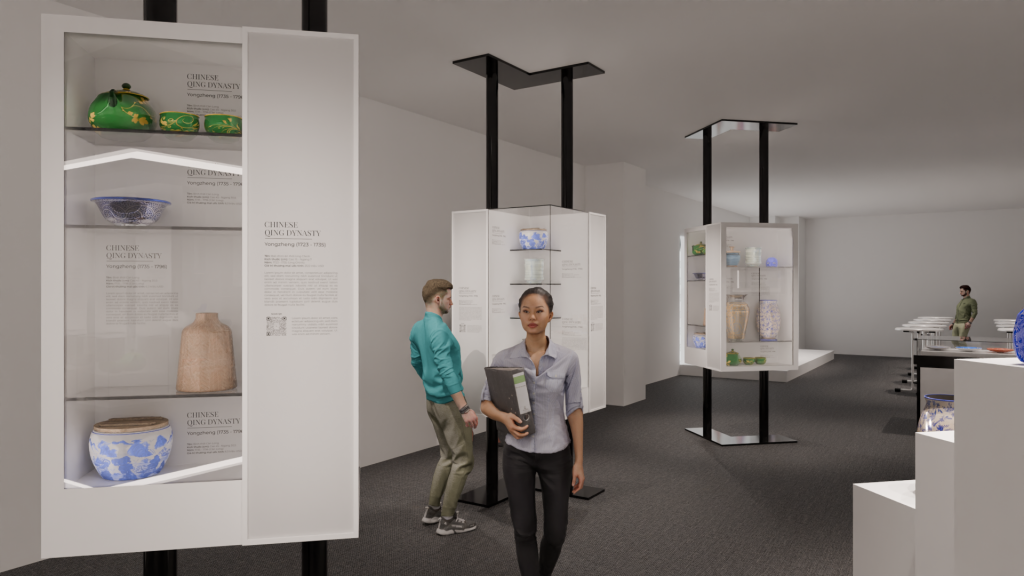Imprinted with the resplendent history of 300 years, the depth of culture, and the pinnacle of Chinese ceramic art, the artifact owned by Emperor Qianlong & Yongzheng (1723-1795), the Yongzheng bowl, is often auctioned for tens of millions of USD at international auctions. What gives these artifacts their enduring value, making them highly sought after in the international market, inspiring endless fascination among experts and artisans for over three centuries and generations to come?

I. Qing Dynasty Ceramics – A Breakthrough in Artistic Colors
Kangxi, Yongzheng, Qianlong – the three greatest emperors of the Qing Dynasty, all showed immense interest in porcelain firing at Jingdezhen, making this period the pinnacle of creativity and porcelain production. Under their talented and knowledgeable reign, porcelain items were developed with many new creative shapes, intricate patterns, and achieved a sublime level of color.
During Yongzheng’s reign, the porcelain products were simple yet extremely sophisticated, meticulous in every brushstroke, especially the white porcelain, which had to meet the criteria of “white as jade, bright as a mirror, thin as paper, and resonant as a bell”. These porcelain artifacts are like “historical witnesses”, telling us the miraculous stories of ancient artisans – talented painters who not only drew exquisite lines but also depicted the grandeur of a prosperous dynasty.
II. The Swallows bowl of Emperor Yongzheng – A Timeless Masterpiece (1723-1735)
The Swallow bowl of Emperor Yongzheng, once owned by Emperor Yongzheng (1723-1735), measures 15cm in height and 7cm in width.
**What is Katiart’s Mission? Why should readers know about Katiart’s Gallery?**
“White as jade, bright as a mirror, thin as paper, and resonant as a bell” are the phrases used by both ancient and modern generations to praise the purity, clarity, and superb craftsmanship of Yongzheng porcelain. The Swallows bowls, with their jade-like white glaze, flawless bright beauty, under the creativity and erudition of the monarch and the talent of ancient artisans.
The motifs on the Swallows bowl of Emperor Yongzheng bear the distinct mark of Eastern culture. On the bright white jade glaze, the image of swallows freely flying in the sky with blooming peach blossoms under the swaying willow branches in the fresh spring breeze creates a painting of spring that is both warm and full of vitality, wishing for a prosperous and enduring dynasty.
- Imperial Seal: “Yongzheng Nian Zhi” proves that the Swallows bowl was crafted and once owned by Emperor Yongzheng.
- Yến Tử – Swallow: The swallow symbolizes longevity, despite its small and fragile body, it has unparalleled resilience and longevity. Additionally, swallows are symbols of peace and good fortune, where swallows appear, there is joy and luck.
- Plum Blossom – Peach Blossom: Peach blossoms, considered the “quintessence of the five elements”, are not only beautiful in form but also carry profound feng shui meanings. They symbolize harmony and connection. Peach blossoms also symbolize fertility and growth, especially when they bloom in early spring.
- Willow Tree: The willow tree symbolizes resilience and strength, overcoming all difficulties to thrive even in harsh conditions. In cultural beliefs, it is believed that the willow tree can bring wealth, luck, longevity, and sustainability.
- The poem: “Ngọc tiễn xuyên hoa quá, nghê thường đới nguyệt quy” – “Swallows dart through blossoms, the celestial maiden’s robe brings the moon home”.
The magneficent dance shines under the moonlight, originating from the Tang Dynasty, recounting the story of Emperor Xuanzong being helped by a Taoist to travel to the moon on the 15th of the lunar month. Upon returning to the human world, he composed the “Nghê Thường Vũ Y Khúc” dance and music. The phrase “Nghê thường đới nguyệt quy” refers to this legend.
“Ngọc tiễn xuyên hoa quá” chỉ đuôi của chim én, làm biểu tượng cho hình ảnh đôi én bay lượn kết hợp cùng họa tiết cây dương liễu và khóm hoa đào nở rộ giữa tiết trời mùa xuân, vẽ lên một bức tranh mùa xuân êm đềm, ấm áp nhưng đầy nhựa sống.
Who is Katiart’s and what is our mission?
A masterpiece of the Qing Dynasty was successfully auctioned for 25 million USD (Source: danviet.vn)
III. Chinese Antiquities: Witnesses of History and Culture Appearing for the First Time in Vietnam
The Swallows bowl is not only a masterpiece of high ceramic art but also a testament to the talent and creative spirit of Qing Dynasty ceramic artisans. The bowl is an invaluable Chinese antique, carrying profound historical and cultural values – recognized by the art elite and embraced by the public who love culture and art for hundreds of years.
Museums & art galleries around the world are places to preserve and display precious Chinese antiques:
- Katiart’s Gallery – Vietnam
- National Palace Museum – Taipei
- The Metropolitan Museum of Art – New York
- Victoria and Albert Museum (V&A) – London
- Musée Guimet – Paris

Katiart’s Gallery not only honors the value of each artifact but also evokes historical stories and human mysteries, inspiring future generations, opening the door to the wonderful world of knowledge and creativity.
The exhibition “Katiart’s – The Essence of Ceramics” is a journey through history, honoring the essence of traditional craftsmanship, from ancient times to the modern era. The displayed works not only carry material value but also embody the culture and soul of humanity through the ages. The exhibition is not only a place to admire the beauty of creations but also a bridge to the past, preserving the mysteries and exquisite techniques passed down through generations.
Related Articles:
